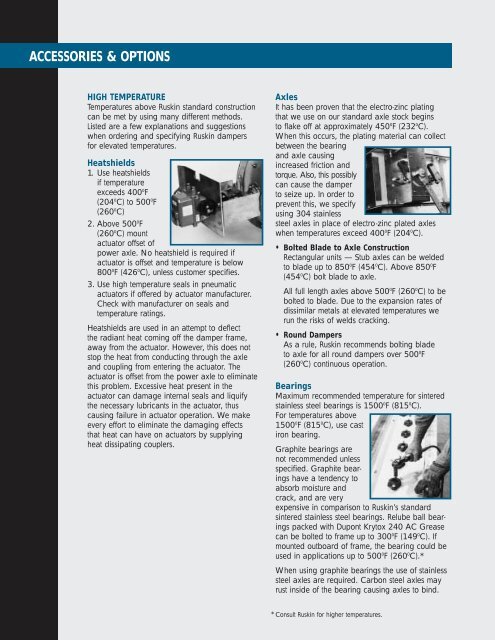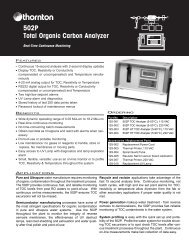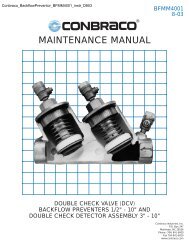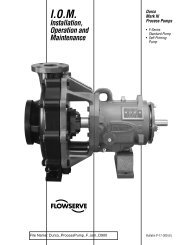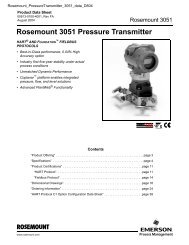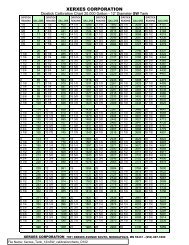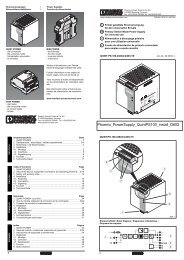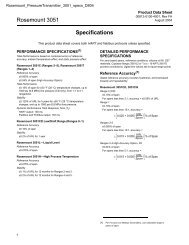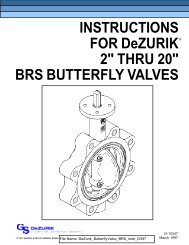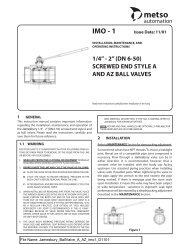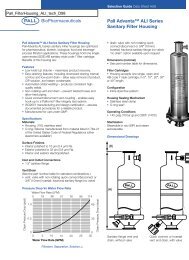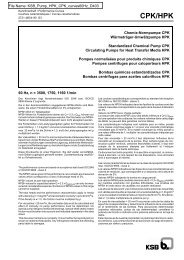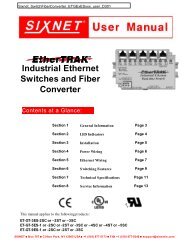industrial rectangular & round dampers
industrial rectangular & round dampers
industrial rectangular & round dampers
Create successful ePaper yourself
Turn your PDF publications into a flip-book with our unique Google optimized e-Paper software.
ACCESSORIES & OPTIONS<br />
HIGH TEMPERATURE<br />
Temperatures above Ruskin standard construction<br />
can be met by using many different methods.<br />
Listed are a few explanations and suggestions<br />
when ordering and specifying Ruskin <strong>dampers</strong><br />
for elevated temperatures.<br />
Heatshields<br />
1. Use heatshields<br />
if temperature<br />
exceeds 4000F (2040C) to 5000F (2600C) 2. Above 5000F (2600C) mount<br />
actuator offset of<br />
power axle. No heatshield is required if<br />
actuator is offset and temperature is below<br />
8000F (4260C), unless customer specifies.<br />
3. Use high temperature seals in pneumatic<br />
actuators if offered by actuator manufacturer.<br />
Check with manufacturer on seals and<br />
temperature ratings.<br />
Heatshields are used in an attempt to deflect<br />
the radiant heat coming off the damper frame,<br />
away from the actuator. However, this does not<br />
stop the heat from conducting through the axle<br />
and coupling from entering the actuator. The<br />
actuator is offset from the power axle to eliminate<br />
this problem. Excessive heat present in the<br />
actuator can damage internal seals and liquify<br />
the necessary lubricants in the actuator, thus<br />
causing failure in actuator operation. We make<br />
every effort to eliminate the damaging effects<br />
that heat can have on actuators by supplying<br />
heat dissipating couplers.<br />
Axles<br />
It has been proven that the electro-zinc plating<br />
that we use on our standard axle stock begins<br />
to flake off at approximately 450 0 F (232 0 C).<br />
When this occurs, the plating material can collect<br />
between the bearing<br />
and axle causing<br />
increased friction and<br />
torque. Also, this possibly<br />
can cause the damper<br />
to seize up. In order to<br />
prevent this, we specify<br />
using 304 stainless<br />
steel axles in place of electro-zinc plated axles<br />
when temperatures exceed 400 0 F (204 0 C).<br />
• Bolted Blade to Axle Construction<br />
Rectangular units — Stub axles can be welded<br />
to blade up to 8500F (4540C). Above 8500F (4540C) bolt blade to axle.<br />
All full length axles above 5000F (2600C) to be<br />
bolted to blade. Due to the expansion rates of<br />
dissimilar metals at elevated temperatures we<br />
run the risks of welds cracking.<br />
• Round Dampers<br />
As a rule, Ruskin recommends bolting blade<br />
to axle for all <strong>round</strong> <strong>dampers</strong> over 500 0 F<br />
(260 0 C) continuous operation.<br />
Bearings<br />
Maximum recommended temperature for sintered<br />
stainless steel bearings is 15000F (8150C). For temperatures above<br />
15000F (8150C), use cast<br />
iron bearing.<br />
Graphite bearings are<br />
not recommended unless<br />
specified. Graphite bearings<br />
have a tendency to<br />
absorb moisture and<br />
crack, and are very<br />
expensive in comparison to Ruskin’s standard<br />
sintered stainless steel bearings. Relube ball bearings<br />
packed with Dupont Krytox 240 AC Grease<br />
can be bolted to frame up to 3000F (1490C). If<br />
mounted outboard of frame, the bearing could be<br />
used in applications up to 5000F (2600C).* When using graphite bearings the use of stainless<br />
steel axles are required. Carbon steel axles may<br />
rust inside of the bearing causing axles to bind.<br />
*<br />
Consult Ruskin for higher temperatures.


